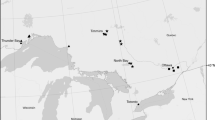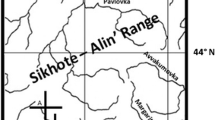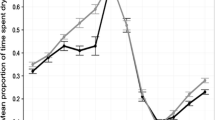Abstract
Sooty Albatrosses (Phoebetria fusca; Endangered) are biennially breeding birds with successful breeders typically spending at least 15 months at-sea (‘sabbatical’) before returning to their breeding grounds on sub-Antarctic islands. Stable isotope analysis of feathers suggests that non-breeding adult Sooty Albatrosses moult in sub-tropical waters, north of the Sub-Tropical Front (STF). The Prince Edward Islands (Marion and Prince Edward) provide nesting grounds for ca 24% of the world’s Sooty Albatrosses. We tracked 20 adult Sooty Albatrosses from Marion Island with geolocators (GLS loggers) and satellite transmitters (PTT) during their non-breeding sabbaticals between 2008 and 2014. Stable isotope analysis also was performed on feathers collected from GLS-tracked birds upon device retrieval. Adult birds mostly remained within international waters in the southern Indian Ocean during their sabbatical period, splitting their time between sub-tropical and sub-Antarctic waters. Sooty Albatrosses were more active during the day on average but spent similar time in flight during full moon periods. Periods of reduced flight activity, measured by time on water, suggest that moulting occurs mainly around the STF. Breeding success influenced moult phenology, with unsuccessful birds moulting in late summer, immediately following a failed breeding attempt (Feb–Mar), whilst successful breeders moulted early the following summer (Oct–Dec). Failed breeders spent more time flying between breeding attempts than successful breeders, particularly whilst moulting. Our study identifies key areas utilised by non-breeding Sooty Albatrosses, which is critical to implement appropriate management strategies that may help population recovery of this endangered species.








Similar content being viewed by others
References
ACAP (2017) Sooty Albatross Phoebetria fusca. Agreem. Conserv. Albatrosses Petrels 14 pp. http://www.acap.aq/ accessed 31 May 2017
Afanasyev V (2004) A miniature daylight level and activity data recorder for tracking animals over long periods. Mem Natl Inst Polar Res Spec Issue 58:227–233
Beal M, Dias MP, Phillips RA, Oppel S, Hazin C, Pearmain EJ, Adams J, Anderson DJ, Antolos M, Arata JA et al (2021) Global political responsibility for the conservation of albatrosses and large petrels. Sci Adv 7:eabd7225
Berruti A (1979) The breeding biologies of the Sooty Albatrosses Phoebetria fusca and P. palpebrata. Emu 79:161–175
Birdlife International (2004) Tracking ocean wanderers: the global distribution of albatrosses and petrels. BirdLife International, Cambridge
Birdlife International (2020) Species factsheet: Phoebetria fusca. http://www.birdlife.org
Boonzaier L, Harper S, Zeller D, Pauly D (2012) A brief history of fishing in the Prince Edward Islands, South Africa, 1950–2010. In: Fisheries catch reconstructions: Islands, Part III. Fisheries Centre Research Reports. pp 95–101
Boyd JD, Brightsmith DJ (2013) Error properties of Argos satellite telemetry locations using least squares and Kalman filtering. PLoS ONE 8:e63051
Bridge ES (2006) Influences of morphology and behavior on wing-molt strategies in seabirds. Mar Ornithol 34:7–19
Calenge C (2006) The package “adehabitat” for the R software: a tool for the analysis of space and habitat use by animals. Ecol Modell 197:516–519
Carpenter-Kling T, Pistorius P, Reisinger R, Cherel Y, Connan M (2020a) A critical assessment of marine predator isoscapes within the southern Indian Ocean. Mov Ecol 8:1–18
Carpenter-Kling T, Reisinger RR, Orgeret F, Connan M, Stevens KL, Ryan PG, Makhado A, Pistorius PA (2020b) Foraging in a dynamic environment: response of four sympatric sub-Antarctic albatross species to interannual environmental variability. Ecol Evol 10:11277–11295
Cherel Y, Hobson KA, Weimerskirch H (2000) Using stable-isotope analysis of feathers to distinguish moulting and breeding origins of seabirds. Oecologia 122:155–162
Cherel Y, Jaeger A, Alderman R, Jaquemet S, Richard P, Wanless RM, Phillips RA, Thompson DR (2013) A comprehensive isotopic investigation of habitat preferences in nonbreeding albatrosses from the Southern Ocean. Ecography 36:277–286
Cherel Y, Quillfeldt P, Delord K, Weimerskirch H (2016) Combination of at-sea activity, geolocation and feather stable isotopes documents where and when seabirds molt. Front Ecol Evol 4:1–16
Clay TA, Manica A, Ryan PG, Silk JRD, Croxall JP, Ireland L, Phillips RA (2016) Proximate drivers of spatial segregation in non-breeding albatrosses. Sci Rep 6:1–13
Cleeland JB, Alderman R, Bindoff A, Lea MA, McMahon CR, Phillips RA, Raymond B, Sumner MD, Terauds A, Wotherspoon SJ et al (2019) Factors influencing the habitat use of sympatric albatrosses from Macquarie Island, Australia. Mar Ecol Prog Ser 609:221–237
Connan M, McQuaid C, Bonnevie B, Smale M, Cherel Y (2014) Combined stomach content, lipid and stable isotope analyses reveal spatial and trophic partitioning among three sympatric albatrosses from the Southern Ocean. Mar Ecol Prog Ser 497:259–272
Connan M, Bonnevie B, McQuaid C (2018) Ontogeny, tissue, and species but not sex influence stable isotopic values of three albatross species. Polar Biol 41:1175–1186
Croxall JP, Silk JRD, Phillips RA, Afanasyev V, Briggs DR (2005) Global circumnavigations: tracking year-round ranges of nonbreeding albatrosses. Science 307:249–250
Croxall JP, Butchart SHM, Lascelles B, Stattersfield AJ, Sullivan B, Symes A, Taylor P (2012) Seabird conservation status, threats and priority actions: a global assessment. Bird Conserv Int 22:1–34
Cuthbert RJ, Cooper J, Ryan PG (2014) Population trends and breeding success of albatrosses and giant petrels at Gough Island in the face of at-sea and on-land threats. Antarct Sci 26:163–171
De Grissac S, Börger L, Guitteaud A, Weimerskirch H (2016) Contrasting movement strategies among juvenile albatrosses and petrels. Sci Rep 6:26103
Delord K, Besson D, Barbraud C, Weimerskirch H (2008) Population trends in a community of large Procellariiforms of Indian Ocean: potential effects of environment and fisheries interactions. Biol Conserv 141:1840–1856
Delord K, Weimerskirch H (2011) New information on distribution of albatrosses and petrels breeding in the Indian Ocean and assessment of potential overlap with the IOTC fisheries. Unpublished report to the Indian Ocean Tuna Commission, Working Party on Ecosystems and Bycatch. p 16
Delord K, Barbraud C, Bost CA, Cherel Y, Guinet C, Weimerskirch H (2013) Atlas of top predators from French Southern Territories in the Southern Indian Ocean. Res Rep CNRS pp 252
Dias MP, Oppel S, Bond AL, Carneiro APB, Cuthbert RJ, González-Solís J, Wanless RM, Glass T, Lascelles B, Small C et al (2017) Using globally threatened pelagic birds to identify priority sites for marine conservation in the South Atlantic Ocean. Biol Conserv 211:76–84
Dias MP, Martin R, Pearmain EJ, Burfield IJ, Small C, Phillips RA, Yates O, Lascelles B, Borboroglu PG, Croxall JP (2019) Threats to seabirds: a global assessment. Biol Conserv 237:525–537
Edwards AE (2008) Large-scale variation in flight feather molt as a mechanism enabling biennial breeding in albatrosses. J Avian Biol 39:144–151
Fieberg J, Kochanny CO (2005) Quanitfying home-range overlap: the importance of the utilization distribution. J Wildl Manage 69:1346–1359
Fridolfsson A-K, Ellegren H (1999) A simple and universal method for molecular sexing of non-ratite birds. J Avian Biol 30:116–121
González-Solís J, Smyrli M, Militão T, Gremillet D, Tveraa T, Phillips R, Boulinier T (2011) Combining stable isotope analyses and geolocation to reveal kittiwake migration. Mar Ecol Prog Ser 435:251–261
Gutowsky SE, Gutowsky LFG, Jonsen ID, Leonard ML, Naughton MB, Romano MD, Shaffer SA (2014) Daily activity budgets reveal a quasi-flightless stage during non-breeding in Hawaiian albatrosses. Mov Ecol 2:23
Hedenström A, Sunada S (1999) On the aerodynamics of moult gaps in birds. J Exp Biol 202:67–76
Hindell MA, Reisinger RR, Ropert-Coudert Y, Hückstädt LA, Trathan PN, Bornemann H, Charrassin JB, Chown SL, Costa DP, Danis B et al (2020) Tracking of marine predators to protect Southern Ocean ecosystems. Nature 580:87–92
Hobson KA (1990) Stable isotope analysis of marbled Murrelets: evidence for freshwater feeding and determination of trophic level. Condor 92:897–903
Hobson KA (1999) Tracing origins and migration of wildlife using stable isotopes: a review. Oecologia 120:314–326
Jaeger A, Blanchard P, Richard P, Cherel Y (2009) Using carbon and nitrogen isotopic values of body feathers to infer inter- and intra-individual variations of seabird feeding ecology during moult. Mar Biol 156:1233–1240
Jaeger A, Connan M, Richard P, Cherel Y (2010a) Use of stable isotopes to quantify seasonal changes of trophic niche and levels of population and individual specialisation in seabirds. Mar Ecol Prog Ser 401:269–277
Jaeger A, Lecomte VJ, Weimerskirch H, Richard P, Cherel Y (2010b) Seabird satellite tracking validates the use of latitudinal isoscapes to depict predators’ foraging areas in the Southern Ocean. Rapid Commun Mass Spectrom 24:3456–3460
Jaeger A, Jaquemet S, Phillips R, Wanless R, Richard P, Cherel Y (2013) Stable isotopes document inter- and intra-specific variation in feeding ecology of nine large southern Procellariiformes. Mar Ecol Prog Ser 490:255–266
Jaeger A, Feare CJ, Summers RW, Lebarbenchon C, Larose CS, Le CM (2017) Geolocation reveals year-round at-sea distribution and activity of a superabundant tropical seabird, the sooty tern Onychoprion fuscatus. Front Mar Sci 4:1–10
Jouventin P, Weimerskirch H (1988) Demographic strategies of southern albatrosses. Proc Int Ornithol Congr 19:857–865
Jouventin P, Weimerskirch H (1990) Satellite tracking of Wandering albatrosses. Nature 343:746–748
Langston N, Rohwer S (1996) Molt-breeding tradeoffs in albatrosses: life history implications for big birds. Oikos 76:498–510
Lutjeharms JRE, Ansorge IJ (2008) Oceanographic setting of the Prince Edward Islands. In: Chown SL, Froneman PW (eds) The Prince Edward Islands: land-sea interactions in a changing ecosystem. SUN Press, Stellenbosch, pp 17–38
Mackley EK, Phillips RA, Silk JRD, Wakefield ED, Afanasyev V, Fox JW, Furness RW (2010) Free as a bird? Activity patterns of albatrosses during the nonbreeding period. Mar Ecol Prog Ser 406:291–303
Magozzi S, Yool A, Vander Zanden HB, Wunder MB, Trueman CN (2017) Using ocean models to predict spatial and temporal variation in marine carbon isotopes. Ecosphere 8:e01763
Mizutani H, Fukuda M, Kabaya Y, Wada E (1990) Carbon isotope ratio of feathers reveals feeding behavior of cormorants. Auk 107:400–403
Nevitt GA, Losekoot M, Weimerskirch H (2008) Evidence for olfactory search in wandering albatross, Diomedea exulans. Proc Natl Acad Sci USA 105:4576–4581
Orben RA, O’Connor AJ, Suryan RM, Ozaki K, Sato F, Deguchi T (2018) Ontogenetic changes in at-sea distributions of immature short-tailed albatrosses Phoebastria albatrus. Endanger Species Res 35:23–37
Orsi AH, Whitworth T, Nowlin WD (1995) On the meridional extent and fronts of the Antarctic circumpolar current. Deep-Sea Res Part I 42:641–673
Pastor-Prieto M, Ramos R, Zajková Z, Reyes-González JM, Rivas ML, Ryan PG, González-Solís J (2019) Spatial ecology, phenological variability and moulting patterns of the Endangered Atlantic petrel Pterodroma incerta. Endanger Species Res 40:189–206
Phalan B, Phillips RA, Silk JR, Afanasyev V, Fukuda A, Fox JW, Catry P, Higuchi H, Croxall JP (2007) Foraging behaviour of four albatrosses species by night and day. Mar Ecol Prog Ser 340:271–286
Phillips RA, Silk JRD, Croxall JP, Afanasyev V, Briggs DR (2004) Accuracy of geolocation estimates for flying seabirds. Mar Ecol Prog Ser 266:265–272
Phillips RA, Silk JRD, Croxall JP, Afanasyev V, Bennett VJ (2005) Summer distribution and migration of nonbreeding albatrosses: individual consistencies and implications for conservation. Ecology 86:2386–2396
Phillips RA, Croxall JP, Silk JRD, Briggs DR (2008) Foraging ecology of albatrosses and petrels from South Georgia: two decades of insights from tracking technologies. Aquat Conserv Mar Freshw Ecosyst 17:S6–S21
Pinheiro J, Bates D (2014) nlme: Linear and nonlinear mixed effects models. R package.
R Development Core Team (2018) R: A language and environment for statistical computing. R Foundation for Statistical Computing, Vienna
Ramos R, Carlile N, Madeiros J, Ramírez I, Paiva VH, Dinis HA, Zino F, Biscoito M, Leal GR, Bugoni L et al (2017) It is the time for oceanic seabirds: tracking year-round distribution of gadfly petrels across the Atlantic Ocean. Divers Distrib 23:794–805
Richardson M (1984) Aspects of the ornithology of the Tristan da Cunha group and Gough Island, 1972–1974. Cormorant 12:123–201
Rishworth GM, Connan M, Green DB, Pistorius PA (2014) Sex differentiation based on the gular stripe in the apparently monomorphic Cape gannet. Afr Zool 49:107–112
Rollinson DP, Dilley BJ, Davies D, Ryan PG (2018) Year-round movements of white-chinned petrels from Marion Island, south-western Indian Ocean. Antarct Sci 30:183–195
Rubenstein DR, Hobson K (2004) From birds to butterflies: animal movement patterns and stable isotopes. Trends Ecol Evol 19:256–263
Ryan PG, Jones MGW, Dyer BM, Upfold L, Crawford RJM (2009) Recent population estimates and trends in numbers of albatrosses and giant petrels breeding at the sub-Antarctic Prince Edward Islands. Afr J Mar Sci 31:409–417
Schoombie S, Crawford RJM, Makhado AB, Dyer BM, Ryan PG (2016) Recent population trends of sooty and light-mantled albatrosses breeding on Marion Island. Afr J Mar Sci 38:119–127
Schoombie S, Dilley BJ, Davies D, Glass T, Ryan PG (2017) The distribution of breeding Sooty Albatrosses from the three most important breeding sites: Gough, Tristan and the Prince Edward Islands. Emu 117:160–169
Sumner MD, Wotherspoon SJ, Hindell MA (2009) Bayesian estimation of animal movement from archival and satellite tags. PLoS ONE 4:e7324
Thiebot JB, Delord K, Marteau C, Weimerskirch H (2014) Stage-dependent distribution of the Critically Endangered Amsterdam albatross in relation to Economic Exclusive Zones. Endanger Species Res 23:263–276
Tickell W (2000) Albatrosses. Pica Press, Sussex
Tuck GN, Polacheck T, Bulman CM (2003) Spatio-temporal trends of longline fishing effort in the Southern Ocean and implications for seabird bycatch. Biol Conserv 114:1–27
Tuck GN, Phillips RA, Small C, Thomson RB, Klaer NL, Taylor F, Wanless RM, Arrizabalaga H (2011) An assessment of seabird – fishery interactions in the Atlantic Ocean. ICES J Marine Sci 68:1628–1637
Von Hünerbein K, Hamann HJ, Rüter E, Wiltschko W (2000) A GPS-based system for recording the flight paths of birds. Naturwissenschaften 87:278–279
Wakefield ED, Phillips RA, Jason M, Akira F, Hiroyoshi H, Marshall GJ, Trathan PN (2009) Wind field and sex constrain the flight speeds of central-place foraging albatrosses. Ecol Monogr 79:663–679
Warham J (1996) The petrels, their ecology and breeding systems. Academic Press, London
Weimerskirch H (1991) Sex-specific differences in molt strategy in relation to breeding in the wandering albatross. Condor 93:731–737
Weimerskirch H, Guionnet T (2002) Comparative activity pattern during foraging of four albatross species. Ibis 144:40–50
Weimerskirch H, Wilson RP (1992) When do wandering albatrosses Diomedea exulans forage? Mar Ecol Prog Ser 86:297–300
Weimerskirch H, Clobert J, Jouventin P (1987) Survival in five southern albatrosses and its relationship with their life history. J Anim Ecol 56:1043–1055
Weimerskirch H, Wilson RP, Lys P (1997) Activity pattern of foraging in the wandering albatross: a marine predator with two modes of prey searching. Mar Ecol Prog Ser 151:245–254
Weimerskirch H, Louzao M, De Grissac S, Delord K (2012) Changes in wind pattern alter albatross distribution and life-history traits. Science 335:211–214
Weimerskirch H, Cherel Y, Delord K, Jaeger A, Patrick SC, Riotte-Lambert L (2014) Lifetime foraging patterns of the wandering albatross: life on the move! J Exp Mar Bio Ecol 450:68–78
Weimerskirch H, Delord K, Guitteaud A, Phillips RA, Pinet P (2015) Extreme variation in migration strategies between and within wandering albatross populations during their sabbatical year, and their fitness consequences. Sci Rep 5:8853
Weimerskirch H, Delord K, Barbraud C, Le Bouard F, Ryan PG, Fretwell P, Marteau C (2018) Status and trends of albatrosses in the French Southern Territories, Western Indian Ocean. Polar Biol 41:1963–1972
Weimerskirch H, Collet J, Corbeau A, Pajot A, Hoarau F, Marteau C, Filippi D, Patrick SC (2020) Ocean sentinel albatrosses locate illegal vessels and provide the first estimate of the extent of nondeclared fishing. Proc Natl Acad Sci 117:3006–3014
Wilson RP, Pütz K, Peters G, Culik BM, Scolaro JA, Charrassin J-B, Ropert-Coudert Y (1997) Long-term attachment of transmitting and recording devices to penguins and other seabirds. Wildl Soc Bull 25:101–106
Wood S (2011) Fast stable restricted maximum likelihood and marginal likelihood estimation of semiparametric generalized linear models. J R Stat Soc B 73:3–36
Acknowledgements
We thank all Marion Island field assistants who assisted in deployment and retrieval of tracking devices and in particular, Bruce Dyer, Kim Stevens, Vonica Perold and Alexis Osborne. Jaimie Cleeland provided assistance with the analysis of geolocator data. The Department of Environmental Affairs provided logistic support on Marion Island. Funding was provided by the FitzPatrick Institute Centre of Excellence and the South African National Antarctic Programme, through the National Research Foundation. Permission to work on seabirds at the Prince Edward Islands was granted by the Prince Edward Islands’ Management Committee. All research was approved by the University of Cape Town’s Science Faculty Animal Ethics Committee. We thank Melinda Conners and two anonymous reviewers for their extensive feedback, ultimately improving the quality of this manuscript.
Funding
Funding was provided by the FitzPatrick Institute Centre of Excellence and the South African National Antarctic Programme, through the National Research Foundation.
Author information
Authors and Affiliations
Contributions
PR and SS conceived and designed the research. ABM, BJD, DD, MC, PGR and SS performed the field work. MC and SS performed molecular analyses of feather samples. SS analysed the tracking data. SS wrote the manuscript with MC and PGR advising on manuscript preparation. PGR supervised the research. All authors read and approved the manuscript.
Corresponding author
Ethics declarations
Conflict of interest
The authors declare there are no competing interests.
Ethical approval
Permission to work on seabirds at the Prince Edward Islands was granted by the Prince Edward Islands’ Management Committee. All research was approved by the University of Cape Town’s Science Faculty Animal Ethics Committee.
Consent to participate
Not applicable.
Additional information
Publisher's Note
Springer Nature remains neutral with regard to jurisdictional claims in published maps and institutional affiliations.
Supplementary Information
Below is the link to the electronic supplementary material.
Rights and permissions
About this article
Cite this article
Schoombie, S., Connan, M., Dilley, B.J. et al. Non-breeding distribution, activity patterns and moulting areas of Sooty Albatrosses (Phoebetria fusca) inferred from geolocators, satellite trackers and biochemical markers. Polar Biol 45, 31–44 (2022). https://doi.org/10.1007/s00300-021-02969-3
Received:
Revised:
Accepted:
Published:
Issue Date:
DOI: https://doi.org/10.1007/s00300-021-02969-3




